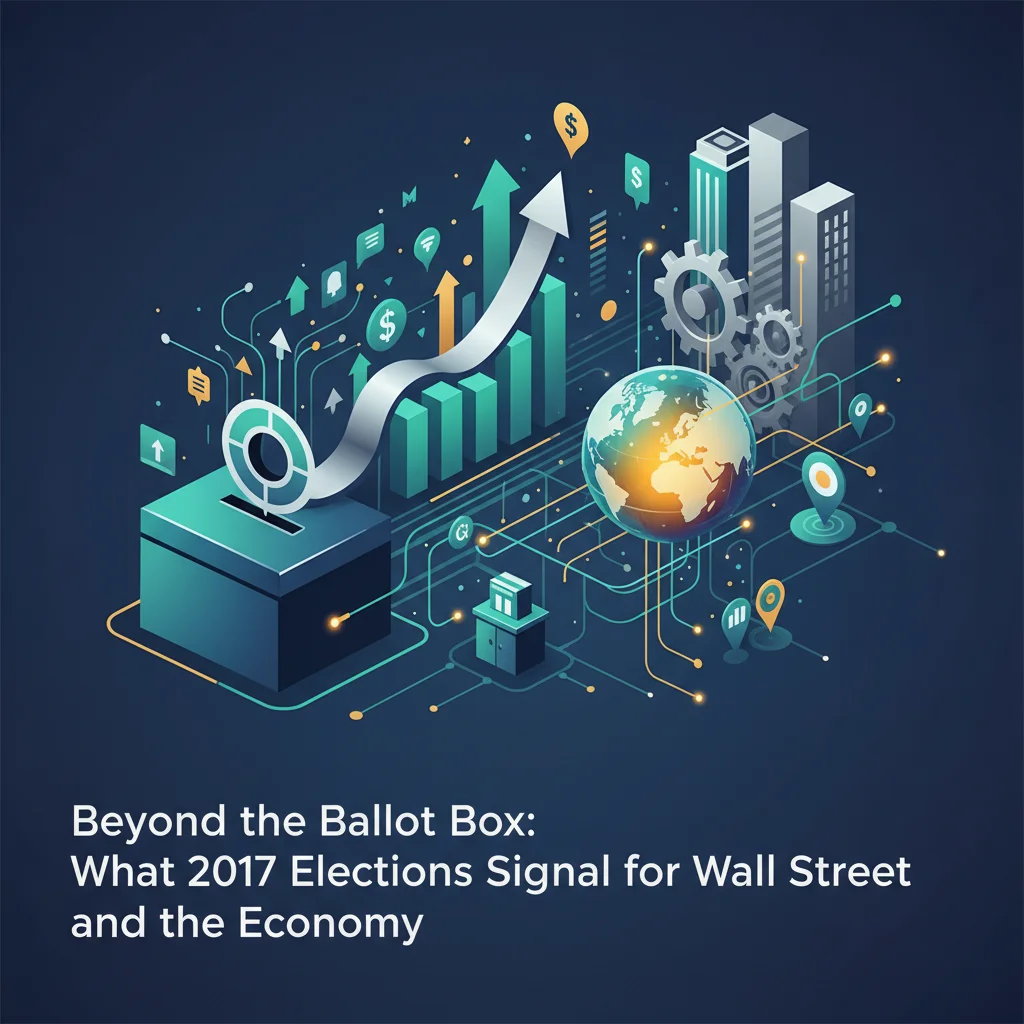
Beyond the Ballot Box: What the 2017 Elections Signal for Wall Street and the Economy
In the world of high-stakes finance and investing, it’s easy to dismiss regional elections as local noise in a market driven by global forces and federal policy. However, savvy investors know that certain off-year elections serve as critical barometers, offering a glimpse into the nation’s political mood and, by extension, the future of the economic landscape. The gubernatorial and mayoral races of November 2017 were a prime example, providing a clear verdict on the political climate one year into the Trump presidency and sending subtle but significant signals to Wall Street, business leaders, and the financial technology sector.
The headline event was the decisive victory for Democrat Ralph Northam in the Virginia governor’s race, a contest that drew national attention as a referendum on the administration’s populist agenda. This, coupled with Democratic wins in New Jersey and New York City, marked a pivotal moment. But what do these political shifts truly mean for your portfolio, the broader stock market, and the trajectory of the U.S. economy? Let’s dissect the results and translate the political tea leaves into actionable financial insights.
A Bellwether in the Old Dominion: Virginia’s Verdict on Economic Policy
The Virginia governor’s race between Ralph Northam and Republican Ed Gillespie was more than a state-level contest; it was a microcosm of the national political debate. Gillespie, a former RNC chairman, initially ran as a traditional pro-business Republican but later adopted more Trump-aligned messaging on cultural issues. The strategy failed to resonate. Northam secured a surprisingly wide nine-point victory in a state that had been considered a tight battleground.
For those in finance, the divergence in their economic platforms was stark and offers a clear view of the competing visions for economic growth at the state level. Understanding these differences is key to anticipating how state-level governance can impact investment opportunities and the business climate.
Below is a breakdown of their core economic positions and the potential market implications:
| Policy Area | Ralph Northam (D) | Ed Gillespie (R) | Potential Economic & Market Impact |
|---|---|---|---|
| State Taxes | Focused on targeted tax relief for the middle class and small businesses; opposed broad, across-the-board cuts. | Proposed a 10% across-the-board income tax cut, arguing it would stimulate the state’s economy. | Northam’s win suggested a focus on shoring up state budgets and public services, a stable but less aggressive approach to growth. Gillespie’s plan could have provided a short-term economic boost but risked state budget shortfalls. |
| Healthcare Policy | Strongly supported expanding Medicaid under the Affordable Care Act, a move covering thousands of Virginians. | Opposed Medicaid expansion, citing long-term costs and fiscal responsibility. | The victory for the pro-expansion candidate was a significant positive for the healthcare sector in Virginia, including hospitals and insurers, by increasing the insured population. This is a crucial factor for healthcare-focused investing. |
| Infrastructure & Tech | Pledged major state investments in transportation, rural broadband, and renewable energy. | Favored public-private partnerships (P3s) and deregulation to encourage private investment. | Northam’s approach signals direct government spending, a boon for construction, materials, and engineering firms. It also highlights a commitment to modernizing the state’s digital infrastructure, a foundational element for the growth of financial technology (fintech). |
| Regulation | Emphasized environmental protection and maintaining a robust regulatory framework for worker protections. | Advocated for significant deregulation to attract business and spur job growth, particularly in the energy sector. | The outcome suggested that voters, even in a swing state, prioritized regulatory stability and environmental concerns over a purely deregulatory agenda. For long-term investors, this can translate to lower risk from environmental liabilities and a more predictable business environment. |
The results in Virginia, along with Democrat Phil Murphy’s gubernatorial win in New Jersey and Bill de Blasio’s re-election in New York City—which saw its strongest mayoral turnout in decades—painted a picture of a suburban electorate pushing back against the political volatility that characterized 2016. This shift has profound implications for the national economic dialogue and the future of sectors from banking to renewable energy.
The New Weapon in Wall Street's Debt Wars: Hedge Funds Unleash Antitrust Law
Translating Political Currents into Investor Strategy
While the immediate reaction on the stock market was negligible—the S&P 500 was more concerned with the forthcoming tax reform bill and Federal Reserve policy—the long-term takeaways for those in finance are significant. Here’s how to interpret these political undercurrents:
- The Future of Regulation in Banking and Finance: A key pillar of the post-2016 market rally was the promise of financial deregulation. The 2017 results showed a growing resistance to the anti-regulatory narrative. A potential shift in congressional power in 2018, foreshadowed by these elections, could mean a halt to further dismantling of Dodd-Frank or other financial protections. State-level elections also matter directly for the banking sector, as state attorneys general and financial regulators play a huge role in enforcement. A more pro-regulatory environment could increase compliance costs for banks but also enhance system-wide stability.
- Sector-Specific Opportunities and Risks: Political outcomes create clear winners and losers across different sectors. Northam’s victory, with its emphasis on Medicaid expansion and infrastructure spending, was a clear positive for healthcare providers and construction firms in the region. Conversely, it signaled a tougher environment for fossil fuel companies facing a pro-environment state administration. As an investor, analyzing the economic platforms of state and federal candidates is essential for effective sector rotation and risk management in your portfolio.
- The Rise of State-Level Economics: With potential for gridlock at the federal level, the importance of state-level economic policy grows. Governors and state legislatures are making critical decisions on everything from data privacy to the regulatory frameworks for emerging technologies like blockchain and fintech. States with forward-thinking policies on financial technology can become innovation hubs, attracting capital and talent. According to a Brookings Institution analysis from the period, states and localities were increasingly becoming the primary drivers of economic policy innovation, a trend investors must monitor.
The £20 Billion Tightrope: Can the Next UK Government Avert a Fiscal Crisis?
The Road Ahead: From 2017 Signals to Long-Term Economic Trends
Looking back, the 2017 elections were a canary in the coal mine for the 2018 “blue wave” midterm elections, which saw Democrats retake the House of Representatives. This shift dramatically altered the legislative possibilities for the remainder of the presidential term, leading to increased political gridlock but also providing a check on more extreme policy proposals. This dynamic of a divided government is something the stock market often digests favorably, as it reduces the likelihood of drastic, market-shaking policy changes.
The key lesson is that politics and economics are inextricably linked. Voter sentiment on display in Virginia and New Jersey was not just about social issues; it was about a vision for the economy, healthcare, and the role of government. These preferences directly influence the investment climate, impacting everything from the valuation of a small-cap biotech firm to the risk profile of a municipal bond.
For professionals in finance, from institutional investors to retail traders, the message is clear: political analysis is a fundamental component of a sound investing strategy. The ability to look past the daily noise of the market and understand the deeper political and social currents shaping the economic landscape is what separates a good investor from a great one. The 2017 elections were a masterclass in this principle, offering a prescient look at the evolving American electorate and the economic future they intended to choose.
Thermo Fisher's Billion Bet: Unpacking the Mega-Deal for Clario and the Future of Drug Development
Ultimately, the verdict delivered by voters in 2017 was a call for moderation and a return to a more predictable style of governance. For the world of finance, which thrives on predictability and clear data, this was a signal that, while political cycles come and go, the fundamentals of a stable, well-regulated, and innovative economy remain the most valuable asset of all.


